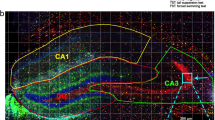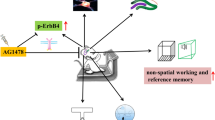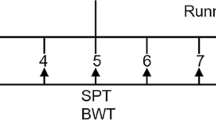Abstract
Physical exercise has been shown to exert antidepressant effects, but the mechanisms underlying this effect are not completely elucidated. Therefore, we aimed at investigating the antidepressant, pro-neurogenic, and neuroprotective effects of physical exercise and the possible role of FNDC5/irisin for this effect. Treadmill running was used as a protocol of physical exercise (45 min/day/5 days/week for 4 weeks) in female Swiss mice. Immobility time was registered in the tail suspension test (TST) and forced swim test (FST). Immunohistochemical analyses to evaluate hippocampal cell proliferation, neuronal survival, and neuronal commitment and maturation, as well as expression of FNDC5 C-terminal fragment were performed in the entire, dorsal, and ventral dentate gyrus (DG) of the hippocampus. Fluoro-Jade B staining was performed to evaluate degenerating neurons in DG. FNDC5 C-terminal and FNDC5/irisin immunocontents were analyzed by western blot. Exposure to physical exercise reduced the immobility time both in the TST and the FST. This antidepressant-like effect was accompanied by an increase in hippocampal cell proliferation, hippocampal neuronal differentiation, and neuronal survival in the dorsal and ventral DG. Fluoro-Jade B staining was reduced in entire and dorsal DG in exercised mice. Finally, physical exercise also resulted in increased number of FNDC5-positive cells in the hippocampal DG as well as elevated FNDC5 C-terminal and FNDC5/irisin immunocontent in the entire hippocampus. The results suggest that the FNDC5 C-terminal fragment/irisin pathway may be implicated in the antidepressant-like, pro-neurogenic, and neuroprotective effects of treadmill running.









Similar content being viewed by others
References
Aydin S, Kuloglu T, Aydin S et al (2014) A comprehensive immunohistochemical examination of the distribution of the fat-burning protein irisin in biological tissues. Peptides 61:130–136. https://doi.org/10.1016/j.peptides.2014.09.014
Banasr M, Soumier A, Hery M et al (2006) Agomelatine, a new antidepressant, induces regional changes in hippocampal neurogenesis. Biol Psychiatry 59:1087–1096. https://doi.org/10.1016/j.biopsych.2005.11.025
Bannerman DM, Rawlins JNP, McHugh SB et al (2004) Regional dissociations within the hippocampus memory and anxiety. Neurosci Biobehav Rev 28:273–283. https://doi.org/10.1016/j.neubiorev.2004.03.004
Barha CK, Davis JC, Falck RS et al (2017) Sex differences in exercise efficacy to improve cognition: A systematic review and meta-analysis of randomized controlled trials in older humans. Front Neuroendocrinol 46:71–85. https://doi.org/10.1016/j.yfrne.2017.04.002
Belviranlı M, Okudan N (2018) Exercise training protects against aging-induced cognitive dysfunction via activation of the hippocampal PGC-1α / FNDC5 / BDNF pathway. Neuro Mol Med. https://doi.org/10.1007/s12017-018-8500-3
Ben Abdallah NMB, Slomianka L, Vyssotski AL, Lipp HP (2010) Early age-related changes in adult hippocampal neurogenesis in C57 mice. Neurobiol Aging 31:151–161. https://doi.org/10.1016/j.neurobiolaging.2008.03.002
Biedermann SV, Fuss J, Steinle J et al (2016) The hippocampus and exercise: histological correlates of MR-detected volume changes. Brain Struct Funct 221:1353–1363. https://doi.org/10.1007/s00429-014-0976-5
Boehme F, Gil-Mohapel J, Cox A et al (2011) Voluntary exercise induces adult hippocampal neurogenesis and BDNF expression in a rodent model of fetal alcohol spectrum disorders. Eur J Neurosci 33:1799–1811. https://doi.org/10.1111/j.1460-9568.2011.07676.x
Boldrini M, Underwood MD, Hen R et al (2009) Antidepressants increase neural progenitor cells in the human hippocampus. Neuropsychopharmacology 34:2376–2389. https://doi.org/10.1038/npp.2009.75
Boström P, Wu J, Jedrychowski MP et al (2012) A PGC1α-dependent myokine that drives browning of white fat and thermogenesis. Nature 481:463–468. https://doi.org/10.1038/nature10777
Bromet E, Andrade LH, Hwang I et al (2011) Cross-national epidemiology of DSM-IV major depressive episode. BMC Med 9:1–16. https://doi.org/10.1186/1741-7015-9-90
Brown JP, Couillard-Després S, Cooper-Kuhn CM et al (2003) Transient expression of doublecortin during adult neurogenesis. J Comp Neurol 467:1–10. https://doi.org/10.1002/cne.10874
Chamari K, Padulo J (2015) ‘Aerobic’ and ‘Anaerobic’ terms used in exercise physiology: a critical terminology reflection. Sport Med Open 1:1–4. https://doi.org/10.1186/s40798-015-0012-1
Christie BR, Cameron HA (2006) Neurogenesis in the adult hippocampus. Hippocampus 16:199–207. https://doi.org/10.1007/s00441-007-0478-3
Cooper-Kuhn CM, Kuhn HG (2002) Is it all DNA repair? Dev Brain Res 134:13–21. https://doi.org/10.1016/S0165-3806(01)00243-7
Couillard-Despres S, Winkler J, Uyanik G, Aigner L (2001) Molecular mechanisms of neuronal migration disorders, quo vadis? Curr Mol Med 1:677–688. https://doi.org/10.2174/1566524013363195
Cunha MP, Oliveira Á, Pazini FL et al (2013) The antidepressant-like effect of physical activity on a voluntary running wheel. Med Sci Sports Exerc 45:851–859. https://doi.org/10.1249/MSS.0b013e31827b23e6
Cunha MP, Pazini FL, Lieberknecht V, Rodrigues ALS (2018) Subchronic administration of creatine produces antidepressant-like effect by modulating hippocampal signaling pathway mediated by FNDC5/BDNF/Akt in mice. J Psychiatr Res 104:78–87. https://doi.org/10.1016/j.jpsychires.2018.07.001
Degroot A, Treit D (2004) Anxiety is functionally segregated within the septo-hippocampal system. Brain Res 1001:60–71. https://doi.org/10.1016/j.brainres.2003.10.065
Dranovsky A, Hen R (2006) Hippocampal neurogenesis: regulation by stress and antidepressants. Biol Psychiatry 59:1136–1143. https://doi.org/10.1016/j.biopsych.2006.03.082
Duman CH, Schlesinger L, Russell DS, Duman RS (2008) Voluntary exercise produces antidepressant and anxiolytic behavioral effects in mice. Brain Res 1199:148–158. https://doi.org/10.1016/j.brainres.2007.12.047
Dun SL, Lyu RM, Chen YH et al (2013) Irisin-immunoreactivity in neural and non-neural cells of the rodent. Neuroscience 240:155–162. https://doi.org/10.1016/j.neuroscience.2013.02.050
Eisch AJ, Mandyam CD (2007) Adult neurogenesis: can analysis of cell cycle proteins move us “Beyond BrdU”? Curr Pharm Biotechnol 8:147–165. https://doi.org/10.2174/138920107780906540
Engin E, Treit D (2007) The role of hippocampus in anxiety: Intracerebral infusion studies. Behav Pharmacol 18:365–374. https://doi.org/10.1097/FBP.0b013e3282de7929
Erickson KI, Voss MW, Prakash RS et al (2010) Exercise training increases size of hippocampus and improves memory. Proc Natl Acad Sci USA 7:3017–3022. https://doi.org/10.1073/pnas.1015950108
Fanselow MS, Dong HW (2010) Are the dorsal and ventral hippocampus functionally distinct structures? Neuron 65:1–25. https://doi.org/10.1016/j.neuron.2009.11.031
Forouzanfar M, Rabiee F, Ghaedi K et al (2015) Fndc5 overexpression facilitated neural differentiation of mouse embryonic stem cells. Cell Biol Int 39:629–637. https://doi.org/10.1002/cbin.10427
Franklin K, Paxinos G (2008) The mouse brain in stereotaxic coordinates, compact, 3rd edn. Elsevier Science, San Diego
Gil-Mohapel J, Brocardo PS, Choquette W et al (2013) Hippocampal neurogenesis levels predict WATERMAZE search strategies in the aging brain. PLoS ONE 8:1–19. https://doi.org/10.1371/journal.pone.0075125
Gonçalves JT, Schafer ST, Gage FH (2016) Adult neurogenesis in the hippocampus: from stem cells to behavior. Cell 167:897–914. https://doi.org/10.1016/j.cell.2016.10.021
Gould E, Tanapat P, McEwen BS et al (1998) Proliferation of granule cell precursors in the dentate gyrus of adult monkeys is diminished by stress. Proc Natl Acad Sci 95:3168–3171. https://doi.org/10.1073/pnas.95.6.3168
Gür FM, Timurkaan S, Gençer Tarakçi B et al (2018) Identification of immunohistochemical localization of irisin in the dwarf hamster (Phodopus roborovskii) tissues. J Vet Med Ser C Anat Histol Embryol 47:174–179. https://doi.org/10.1111/ahe.12345
Hall CS (1934) Emotional behavior in the rat. J Comp Psychol 18:385–403. https://doi.org/10.1037/h0071444
Hassanzadeh S, Jameie SB, Mehdizadeh M et al (2018) FNDC5 expression in Purkinje neurons of adult male rats with acute spinal cord injury following treatment with methylprednisolone. Neuropeptides 70:16–25. https://doi.org/10.1016/j.npep.2018.05.002
Horgusluoglu E, Nudelman K, Nho K, Saykin AJ (2017) Adult neurogenesis and neurodegenerative diseases: a systems biology perspective. Am J Med Genet Part B 174:93–112. https://doi.org/10.1002/ajmg.b.32429
Ieraci A, Madaio AI, Mallei A et al (2016) Brain-derived neurotrophic factor Val66Met human polymorphism impairs the beneficial exercise-induced neurobiological changes in mice. Neuropsychopharmacology 41:3070–3079. https://doi.org/10.1038/npp.2016.120
Inoue K, Okamoto M, Shibato J et al (2015) Long-term mild, rather than intense, exercise enhances adult hippocampal neurogenesis and greatly changes the transcriptomic profile of the hippocampus. PLoS ONE 10:1–25. https://doi.org/10.1371/journal.pone.0128720
Kempermann G, Kuhn G, Gade F (1997) More hippocampal neurons in adult mice living in an enriched enviroment. Nature 6624:493–495. https://doi.org/10.1038/386493a0
Kempermann G, Jessberger S, Steiner B, Kronenberg G (2004) Milestones of neuronal development in the adult hippocampus. Trends Neurosci 27:447–452. https://doi.org/10.1016/j.tins.2004.05.013
Kiiskinen A, Heikkinen E (1976) Physical training and connective tissues in young mice-heart. Eur J Appl Physiol 35:167–171. https://doi.org/10.1007/BF02336190
Kondo M, Nakamura Y, Ishida Y, Shimada S (2014) The 5-HT3 receptor is essential for exercise-induced hippocampal neurogenesis and antidepressant effects. Mol Psychiatry 20:1428–1437. https://doi.org/10.1038/mp.2014.153
Krogh J, Rostrup E, Thomsen C et al (2014) The effect of exercise on hippocampal volume and neurotrophines in patients with major depression a randomized clinical trial. J Affect Disord 165:24–30. https://doi.org/10.1016/j.jad.2014.04.041
Lee H, Ohno M, Ohta S, Mikami T (2013) Regular moderate or intense exercise prevents depression-like behavior without change of hippocampal tryptophan content in chronically tryptophan-deficient and stressed mice. PLoS ONE 8:1–8. https://doi.org/10.1371/journal.pone.0066996
Lee P, Linderman JD, Smith S et al (2014) Irisin and FGF21 are cold-induced endocrine activators of brown fat function in humans. Cell Metab 19:302–309. https://doi.org/10.1016/j.cmet.2013.12.017
Li DJ, Li YH, Yuan HB et al (2017) The novel exercise-induced hormone irisin protects against neuronal injury via activation of the Akt and ERK1/2 signaling pathways and contributes to the neuroprotection of physical exercise in cerebral ischemia. Metabolism 68:31–42. https://doi.org/10.1016/j.metabol.2016.12.003
Lou S, Liu J, Chang H, Chen P (2008) Hippocampal neurogenesis and gene expression depend on exercise intensity in juvenile rats. Brain Res 1210:48–55. https://doi.org/10.1016/j.brainres.2008.02.080
Lourenço MV, Frozza RL, de Freitas GB et al (2019) Exercise-linked FNDC5/irisin rescues synaptic plasticity and memory defects in Alzheimer’s models. Nat Med 1:165–175. https://doi.org/10.1038/s41591-018-0275-4
Lowry OH, Rosebrough NJ, Farr AL, Randall RJ (1951) Protein measurement with the Folin phenol reagent. J Biol Chem 139:265–275. https://doi.org/10.1016/0304-3894(92)87011-4
Ma X, Hamadeh MJ, Christie BR et al (2012) Impact of treadmill running and sex on hippocampal neurogenesis in the mouse model of amyotrophic lateral sclerosis. PLoS ONE 7(4):e36048. https://doi.org/10.1371/journal.pone.0036048
MacQueen GM, Campbell S, McEwen BS et al (2003) Course of illness, hippocampal function, and hippocampal volume in major depression. Proc Natl Acad Sci 100:1387–1392. https://doi.org/10.1073/pnas.0337481100
Malberg JE, Malberg JE, Eisch AJ et al (2000) Chronic antidepressant treatment increases neurogenesis in adult rat hippocampus. J Neurosci 20:9104–9110. https://doi.org/10.1523/JNEUROSCI.20-24-09104.2000
Manev H, Uz T, Smalheiser NR, Manev R (2001) Antidepressants alter cell proliferation in the adult brain in vivo and in neural cultures in vitro. Eur J Pharmacol 411:67–70. https://doi.org/10.1016/S0014-2999(00)00904-3
Marlatt MW, Lucassen PJ, van Praag H (2010) Comparison of neurogenic effects of fluoxetine, duloxetine and running in mice. Brain Res 1341:93–99. https://doi.org/10.1016/j.brainres.2010.03.086
McKinnon MC, Yucel K, Nazarov A, MacQueen GM (2009) A meta-analysis examining clinical predictors of hippocampal volume in patients with major depressive disorder. J Psychiatry Neurosci 34:41–54. https://doi.org/10.1108/14636641211204478
Miller BR, Hen R (2015) The current state of the neurogenic theory of depression and anxiety. Curr Opin Neurobiol 30:51–58. https://doi.org/10.1016/j.conb.2014.08.012
Mizuno E, Wakimoto Y, Nomura M et al (2018) Effects of different exercises on the growth plate in young growing mice. Biomed Res 29(12):2620–2626. https://doi.org/10.4066/biomedicalresearch.29-18-581
Moon H, Dincer F, Mantzoros C (2013) Pharmacological concentrations of irisin increase cell proliferation without influencing markers of neurite outgrowth and synaptogenesis in mouse H19–7 hippocampal cell lines. Metabolism 62:1131–1136
Munive V, Santi A, Torres-Aleman I (2016) A concerted action of estradiol and insulin like growth factor i underlies sex differences in mood regulation by exercise. Sci Rep 6:1–10. https://doi.org/10.1038/srep25969
Mura G, Moro MF, Patten SB, Carta MG (2013) Exercise as an add-on strategy for the treatment of major depressive disorder: a systematic review. CNS Spectr 19:496–508. https://doi.org/10.1017/S1092852913000953
Nokia MS, Lensu S, Ahtiainen JP et al (2016) Physical exercise increases adult hippocampal neurogenesis in male rats provided it is aerobic and sustained. J Physiol 594:1855–1873. https://doi.org/10.1113/JP271552
Otte C, Gold SM, Penninx BW et al (2016) Major depressive disorder. Nat Rev 2:1–20. https://doi.org/10.1038/nrdp.2016.65
Pang M, Yang J, Rao J et al (2018) Time-dependent changes in increased levels of plasma irisin and muscle PGC-1&i&α&/i& and FNDC5 after exercise in mice. Tohoku J Exp Med 244:93–103. https://doi.org/10.1620/tjem.244.93
Park JH, Kim IH, Ahn JH et al (2019) Pretreated Oenanthe Javanica extract increases anti-inflammatory cytokines, attenuates gliosis, and protects hippocampal neurons following transient global cerebral ischemia in gerbils. Neural Regen Res 14:1536–1543. https://doi.org/10.4103/1673-5374.255973
Pazini FL, Cunha MP, Azevedo D et al (2017) Creatine prevents corticosterone-induced reduction in hippocampal proliferation and differentiation: possible implication for its antidepressant effect. Mol Neurobiol 54:6245–6260. https://doi.org/10.1007/s12035-016-0148-0
Pazini FL, Cunha MP, Rodrigues ALS (2019) The possible beneficial effects of creatine for the management of depression. Prog Neuropsychopharmacol Biol Psychiatry 89:193–206. https://doi.org/10.1016/j.pnpbp.2018.08.029
Pedersen BK (2013) Muscle as a secretory organ. Comp Physiol 3:1337–1362. https://doi.org/10.1002/cphy.c120033
Pedersen BK, Febbraio MA (2012) Muscles, exercise and obesity: Skeletal muscle as a secretory organ. Nat Rev Endocrinol 8:457–465. https://doi.org/10.1038/nrendo.2012.49
Piya MK, Harte AL, Sivakumar K et al (2014) The identification of irisin in human cerebrospinal fluid: influence of adiposity, metabolic markers, and gestational diabetes. Am J Physiol Metab 306:E512–E518. https://doi.org/10.1152/ajpendo.00308.2013
Porsolt R, Le PM, Jalfre M (1977) Depression: a new animal model sensitive to antidepressant treatments. Nature 266:730–732. https://doi.org/10.1038/267585a0
Rao MS, Hattiangady B, Shetty AK (2006) The window and mechanisms of major age-related decline in the production of new neurons within the dentate gyrus of the hippocampus. Aging Cell 5:545–558. https://doi.org/10.1111/j.1474-9726.2006.00243.x
Rethorst CD, Wipfli BM, Landers DM (2009) The antidepressive effects of exercise: a meta-analysis of randomized trials. Sport Med 39:491–511. https://doi.org/10.2165/00007256-200939060-00004
Roca-Rivada A, Castelao C, Senin LL et al (2013) FNDC5/irisin is not only a myokine but also an adipokine. PLoS ONE 8:1–10. https://doi.org/10.1371/journal.pone.0060563
Rosa JM, Pazini FL, Olescowicz G et al (2019) Prophylactic effect of physical exercise on Aβ 1–40-induced depressive-like behavior: Role of BDNF, mTOR signaling, cell proliferation and survival in the hippocampus. Prog Neuro-Psychopharmacol Biol Psychiatry 94:109646–109660. https://doi.org/10.1016/j.pnpbp.2019.109646
Santarelli L, Saxe M, Gross C et al (2003) Requirement of hippocampal neurogenesis for the behavioral effects of antidepressants. Science 80:805–809. https://doi.org/10.1126/science.1083328
Schmaal L, Veltman DJ, Van Erp TGM et al (2016) Subcortical brain alterations in major depressive disorder: findings from the ENIGMA Major Depressive Disorder working group. Mol Psychiatry 21:806–812. https://doi.org/10.1038/mp.2015.69
Schmued LC, Hopkins KJ (2000) Fluoro-Jade B: A high affinity fluorescent marker for the localization of neuronal degeneration. Brain Res 874:123–130. https://doi.org/10.1016/S0006-8993(00)02513-0
Schnyder S, Handschin C (2015) Europe PMC funders group skeletal muscle as an endocrine organ: PGC-1 α, myokines and exercise. Bone 80:115–125. https://doi.org/10.1016/j.bone.2015.02.008
Scholzen T, Gerdes J (2000) The Ki-67 protein: from the known and the unknown. J Cell Physiol 322:311–322. https://doi.org/10.1002/(sici)1097-4652(200003)182:3%3c311:aid-jcp1%3e3.0.co;2-9
Schumacher MA, Chinnam N, Ohashi T et al (2013) The structure of Irisin reveals a novel intersubunit β-sheet fibronectin type III (FNIII) dimer: implications for receptor activation. J Biol Chem 288:33738–33744. https://doi.org/10.1074/jbc.M113.516641
Searle A, Calnan M, Lewis G et al (2011) Patients’ views of physical activity as treatment for depression: a qualitative study. Br J Gen Pract 61:149–156. https://doi.org/10.3399/bjgp11X567054
Sierakowiak A, Mattsson A, Gómez-Galán M et al (2015) Hippocampal morphology in a rat model of depression: the effects of physical activity. Open Neuroimag J 9:1–6. https://doi.org/10.2174/1874440001509010001
Siteneski A, Cunha MP, Lieberknecht V et al (2018) Central irisin administration affords antidepressant-like effect and modulates neuroplasticity-related genes in the hippocampus and prefrontal cortex of mice. Prog NeuroPsychopharmacol Biol Psychiatry 84:294–303. https://doi.org/10.1016/j.pnpbp.2018.03.004
So JH, Huang C, Ge M et al (2017) Intense exercise promotes adult hippocampal neurogenesis but not spatial discrimination. Front Cell Neurosci 11:1–12. https://doi.org/10.3389/fncel.2017.00013
Steru L, Chermat R, Thierry B, Simon P (1985) A new method for screening antidepressants in mice. Behav Neural Biol. https://doi.org/10.1007/BF00428203
Sung YH (2015) Effects of treadmill exercise on hippocampal neurogenesis in an MPTP /probenecid-induced Parkinson’s disease mouse model. J Phys Ther Sci 27:3203–3206. https://doi.org/10.1589/jpts.27.3203
Triviño-Paredes J, Patten AR, Gil-Mohapel J, Christie BR (2016) The effects of hormones and physical exercise on hippocampal structural plasticity. Front Neuroendocrinol 41:23–43. https://doi.org/10.1016/j.yfrne.2016.03.001
Praag H, Kempermann G, Gage FH (1999) Running increases cell proliferation and neurogenesis in the adult mouse dentate gyrus. Nat Am Inc 2:266–270.
Van der Borght K, Havekes R, Bos T et al (2007) Exercise Improves Memory Acquisition and Retrieval in the Y-Maze Task: Relationship With Hippocampal Neurogenesis. Behav Neurosci 121:324–334. https://doi.org/10.1037/0735-7044.121.2.324
Videbech P, Ravnkilde B (2004) Hippocampal volume and depression: a meta-analysis of MRI studies. Am J Psychiatry 161:1957–1966. https://doi.org/10.1023/A:1016543307592
Vivar C (2015) Adult hippocampal neurogenesis, aging and neurodegenerative diseases: possible strategies to prevent cognitive impairment. Curr Top Med Chem 15:2175–2192. https://doi.org/10.2174/1568026615666150610141524
Wang S, Pan J (2016) Irisin ameliorates depressive-like behaviors in rats by regulating energy metabolism. Biochem Biophys Res Commun 474:22–28. https://doi.org/10.1016/j.bbrc.2016.04.047
Winner B, Winkler J (2015) Adult neurogenesis in neurodegenerative diseases. Cold Spring Harb Perspect Biol 7:a021287. https://doi.org/10.1101/cshperspect.a021287
Wrann CD, White JP, Salogiannnis J et al (2013) Exercise induces hippocampal BDNF through a PGC-1α/FNDC5 pathway. Cell Metab 18:649–659. https://doi.org/10.1016/j.cmet.2013.09.008
Xia DY, Huang X, Bi CF et al (2017) PGC-1α or FNDC5 is involved in modulating the effects of Aβ1-42oligomers on suppressing the expression of BDNF, a beneficial factor for inhibiting neuronal apoptosis, Aβ deposition and cognitive decline of APP/PS1 Tg mice. Front Aging Neurosci 9:1–10. https://doi.org/10.3389/fnagi.2017.00065
Zhan G, Huang N, Li S et al (2018) PGC-1α–FNDC5–BDNF signaling pathway in skeletal muscle confers resilience to stress in mice subjected to chronic social defeat. Psychopharmacology 235:3351–3358. https://doi.org/10.1007/s00213-018-5041-2
Zhu X, Liu J, Huang S et al (2019) Neuroprotective effects of isoliquiritigenin against cognitive impairment via suppression of synaptic dysfunction, neuronal injury, and neuroinflammation in rats with kainic acid-induced seizures. Int Immunopharmacol 72:358–366. https://doi.org/10.1016/j.intimp.2019.04.028
Acknowledgements
This study was supported by grants from Conselho Nacional de Desenvolvimento Científico e Tecnológico (CNPq) [Grant numbers # 310113/2017–2, #150082/2018–5, 403120/2012–8] and Coordenação de Aperfeiçoamento de Pessoal de Nível Superior (CAPES). ALSR and PSB are recipients of CNPq Research Productivity Fellowship. A.C. thank the FAPESC scholarship. The authors would like to thank the Laboratório Multiusuário UFSC (LAMEB) for the use of some of the equipment required to complete this work, as well as Servier Medical Arts and Mind the Graph for providing images for figures.
Author information
Authors and Affiliations
Corresponding author
Ethics declarations
Conflict of interest
The authors declare that they have no conflict of interest.
Ethical approval
All applicable international, national, and/or institutional guidelines for the care and use of animals were followed.
Additional information
Publisher's Note
Springer Nature remains neutral with regard to jurisdictional claims in published maps and institutional affiliations.
Rights and permissions
About this article
Cite this article
Siteneski, A., Olescowicz, G., Pazini, F.L. et al. Antidepressant-like and pro-neurogenic effects of physical exercise: the putative role of FNDC5/irisin pathway. J Neural Transm 127, 355–370 (2020). https://doi.org/10.1007/s00702-020-02143-9
Received:
Accepted:
Published:
Issue Date:
DOI: https://doi.org/10.1007/s00702-020-02143-9




